Throughout Asia, the lion dance is a traditional event in which trained acrobatic performers impersonate the movements of a mythical Chinese lion. Of all the festivities in which the lion dance appears, the most significant is during Chinese New Year celebrations in which they are supposed to invite fortune and luck to businesses, events and festivals. This set was released alongside the 80105 Chinese New Year Temple Fair, both of which can be combined to create a larger atmosphere of a celebration. 80104 Lion Dance comes with 882 pieces, a new rat costume minifigure, and retails for US $79.99 | CAN $109.99 | UK £64.99. Let’s take a closer look at this set to see how it captures the spirit of such a unique event.
The Box, Instructions and Contents
The front of the box illustrates the complete playset in action. One thing noticeable is that the models in the images on the box are not to scale. For example, the structure with orange rooftops in the background appears to be fictionally larger in the distance. Outside of that, the box art also features line art of a rat celebrating the Year of a Rat, which begins on January 25, 2020. The upper right-hand corner includes a golden logo printed with the word 春 (Chūn) (spring), along with a note on its status as a special edition set. Red and gold are especially popular in Chinese culture, which is why these colours are prominent in both the box art and selection of elements used throughout the build. Red represents joy, luck and happiness, while gold symbolizes wealth.
Included in the set are six bags and a sealed instruction booklet. Just like the Chinese New Year Temple Fair, all decorated elements are printed instead of using stickers. This is certainly welcome, as this festival-themed set can be reused for display in homes for years to come — Say goodbye to peeling stickers.
LEGO spared no expense with the number of printed parts in this set. There are a total of 5 lions in 3 different colours, and each one utilizes six printed 2×2 curved slopes. A red 2×3 tile is printed with 大吉大利 [dàjídàlì], which translates to wishing great luck and great prosperity. There are two sets of round corner 2×2 macaroni pieces forming part of the mouth/teeth for the lion to provide variety. These are printed on white and yellow elements, adding a little bit of variety.
For the first time, the banana element and frog appear in white. The decorated red ball element makes a comeback from last year’s 80102 Dragon Dance. There are a couple decorated 1×2 and 1×4 tiles that also appear in the Chinese New Year Temple Fair set. Upon the first appearance of images of the set, the most talked-about parts were the lions’ eyes and how they were constructed. It’s simply a voodoo ball with eye prints, which are in turn locked into place inside 2×2 inverted domes with a single stud. The other standout part is the round 2×2 slide shoe that mounts onto the head of the lion.
The Build Experience
While the gate structure feels strikingly familiar to that of the one in the Temple Fair set, it’s slightly different in scale and display. With a smaller scale to work with, the iconic look of the upturned eaves is achieved through use of golden frogs placed in each corner.
The gate is built symmetrically on both sides, so you can display it either way and it’ll look exactly the same.
A platform structure is built with tan coloured plates to form a curved “C” shape.
The completed platform has 8 pole beams with smaller 2×2 round jumper plates atop each one. This feature is meant for the lion dancers to perform and hop from one plate to another. The dexterity required to have animal-like moves without missing your step is important and requires practice as one jumps from platform to platform. This structure is also used for lion dance competitions where teams perform various acrobatics to outmatch competing dancers.
Here’s an image illustrating the proper scale of the two builds, which is slightly misleading on the box art where the gate seems to be much larger than the platform.
The next build is an area for the band members, and it features a traditional drum and small gong. The significance of this detail is that, during the performance, the band plays bold and loud drum beats to build the atmosphere of the event. Music from the band also helps the lion dance performers to be in sync with their movements and dance steps.
The band is a core part of the performance, and they travel together with the lion dancers and practice as a team.
A brief background on the origins of the lions
Before we take a look at the stars of the show, the lions, let’s try to address the issue of why they don’t look anything like the lions at the zoo we’re all familiar with. These lions (as also described by LEGO designer Marcus Rollbühler) are from Chinese mythology, depicting the Nian beast (年兽) [nián shòu] that lives under the sea or deep in the mountains and attacks villages to feed on people and animals. The description given is what it resembles today — a flat-faced lion combined with a dog-like body and large teeth. Its weaknesses are the colour red and loud noises, hence the tie-in of noise from the band, firecrackers to scare and distract the lion, and the prominent use of red during the festivities. Today, the lion has become incorporated as a part of modern Chinese New Year celebrations.
The features on the lion’s head are made up of the unique parts we saw earlier. For example, there are the voodoo balls as eyes mentioned earlier. There are also two plates forming the teeth clipped to the lower jaw, and the bananas highlight the brows above the eyes.
Each lion also comes with a set of two minifig legs with printed patterns to match its colour scheme.
1×1 Modified rounded plates with handles are used to secure the decorated 2×2 curved slopes, while the handles remain exposed to imitate ornate trimmings of the costume.
What results are tiny, colourful, mystical Nian lions. What makes them stand out are the printed parts on their bodies, coupled with the unique eyes. When viewed from afar, the signature teeth are instantly recognizable and leave little doubt that these are lion dance costumes with performers hidden inside. I’d also say that these are purposefully designed to be minifigure scale because the two sets of legs are to scale with the overall length and height of the lions.
There are a total of five lions — Two in red as above, two in gold and yellow, and one in white and red.
The size of the lion’s head is purposefully enlarged as it would be in real life, so the scale at which this is built is accurate. In real life, the legs are technically the only visible parts of the performer you’re supposed to see. However, the performer at the front actually has some level of visibly via the mouth opening, which isn’t a practical design here. As you might expect, this means the performer controlling the hindquarters will have to practice quite a bit to be in sync with their partner manning the head controls.
The lions balance quite well with a single stud secured to the bottom of each foot, allowing them to be placed and displayed like a real performance.
In case you’ve noticed the green hairpiece piece that stands out from the red and gold, it’s supposed to represent a piece of lettuce. In modern Asian events where lion dancers perform, they travel as a troupe and visit homes and business offices via prearranged invitations (of course) during the week-long celebrations. A large red envelope can be clipped to the lion’s mouth.
The customary dance highlights the plucking of the greens “cǎi qīng” (採青), in which the piece of lettuce is hung on a pole or placed on a table typically located at the entrance or front of the home or office.
The Meaning Behind the Lion Dance
The lion performers will slowly approach the lettuce in a dance very much like a curious and inquisitive animal and will pretend to consume and devour the lettuce. The red envelope Hóngbāo 紅包 (red packet) is hidden inside the lettuce as a reward to the dance troupe. The aftermath is a mess of torn lettuce depicting the spitting out of the lettuce. This makes more sense when you understand the following…. In Chinese, the same word pronounced with different intonations gives it a different meaning. The key word here is “cai”. The vegetable (cài, 菜) is plucked (cǎi, 採) and the lion spits out the fortune (cái, 财), which is akin to scattering of riches. In short, lion dances are supposed to bring good luck and fortune to homes and businesses.
The Minifigures
Eight minifigures are supplied with this set. They exceed the expectations of what was provided in the Chinese New Year Temple Fair, as all the included figures (except the mayor) have printed legs.
The most important figure of all is the person in a rat costume to celebrate the Year of the Rat. Considering Collectible Minifigure (CMF) fans’ desire to grow their ever-popular animal costume collection, it will likely be highly sought after. It comes with a torso print depicting traditional dress, including a sash extending down the left leg.
There’s a mayor minifigure holding an unused paintbrush. The significance here is that the mayor would be doing the final painting of the lion’s features. This action of dotting the lion’s eye and various other decorations symbolize the giving of life to the Lion. Finishing the eyes gives sight to the Lion, the ears for hearing the drums, the mouth for eating, and various parts of the body to bring it to life and begin the ceremony.
The band member wields two drumsticks to beat the drums, wears a bandanna, and is dressed up in traditional costume.
The second band member is dressed similarly and wields a single drumstick.
The final member is dressed in the same outfit and wields two cymbals.
Three other characters roam the scene. The first is a woman with here hair in a ponytail, and she’s holding a firecracker to scare the lion with.
A second female figure also has a firecracker but sports a sideways facing ponytail.
Last but not least, we have the member preparing the lettuce for devouring. It’s worth noting that these additional figures sport the same colour combinations of the lions and have the same legs as the dancers (not visible to us). The costumes are intricate in detail to match the traditional dress used during the festivities.
Summary
When compared to the Chinese New Year Temple Fair, this set is a much simpler build. From the perspective of a builder, it’s a quick build that is almost underwhelming with the repetitiveness of building the five lions. On the positive side, the printed parts add colour and life to the smaller builds which makes sense when you have a lower piece count and are building smaller models.
Despite the simplicity, there is an intense attention to detail here. With appreciation of the various meanings behind the design choices, special elements, significance of each activity in the festivities and legend behind the lions, the set becomes more appealing and grows on you. LEGO also designed this to be combined with the Chinese New Year Temple Fair, creating a bigger scene. This is also a great way to integrate the story into a larger world. And with the tiny stand-alone lions looking so great, I’d probably sneak a few of these on my desk for display at the office to bring me good luck and fortune for 2020. Maybe you should too?
The LEGO 80104 Lion Dance is currently available worldwide via the LEGO Store and comes with 8 minifigures and 882 pieces | US $79.99 | CAN $109.99 | UK £64.99.
Check out our full gallery below:









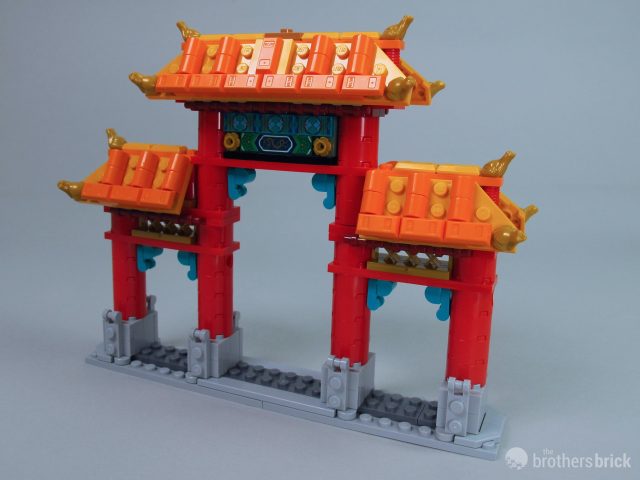









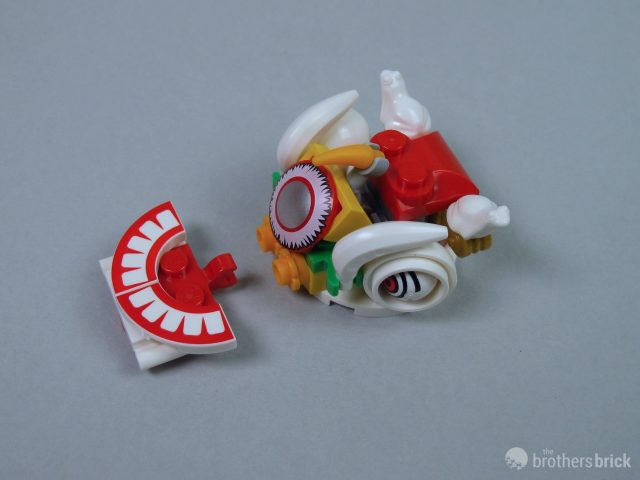




































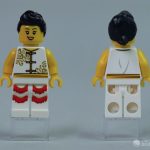

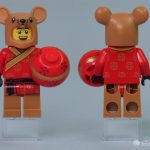



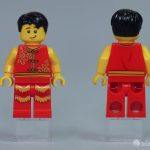
















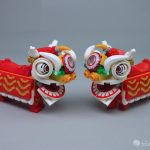








The mayor looks like commissioner Gordon.